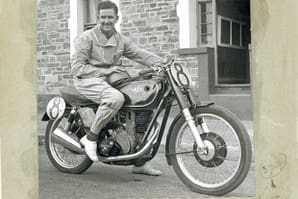
Anderson didn’t make his TT debut until 1939, aged 30, then of course war intervened, during which he served in the navy as skipper of an Admiralty ferry crew and was mentioned in dispatches.
By the time of our photograph, Fergus Anderson was already 40 years old, an age when many sportsmen would be either retired or considering retirement. Anderson, though, was basically only just embarking on what was to be a successful, full, top level career. However, it all ended tragically, when he was killed during a meeting at Floreffe in Belgium in 1956.
Enjoy more Classic MotorCycle reading in the monthly magazine.
Click here to subscribe & save.
Though considered a Scot, Anderson was actually born in England, in February 1909. He was however by no means an obsessive motorcyclist, being also a keen amateur golfer of championship standard, a professional sailor with a love of the sea, an avid reader, an enthusiastic ‘foodie’, a speaker of four languages and a writer of some note. Indeed, as a young man he worked for The Motor Cycle, then held a journalistic position in Hamburg while pursuing his dreams of being a professional racer.
Success on track didn’t come instantly though – during the 1930s he raced for seven years in the UK and on the continent, the decade’s activities culminating in his TT debut in 1939 when he raced a pair of DKWs, a 350cc and a 500cc version, hardly setting the world alight with retirement in the Junior and a 28th place finish in the Senior. Then it was of course off to war.
Following the cessation of hostilities, Anderson was quickly back to racing and soon his activities and achievements seem to have notched up several levels, with among his successes victory in the 1947 350cc Swiss Grand Prix, that year designated the race which constituted the European championship. He was aboard his privately purchased MkVIII KTT Velocette. But what really set him on the path to success though, was his relationship with the Italian Moto Guzzi factory. During the inaugural world championship year, 1949, Anderson secured eighth in the championship, his performances – and probably his determined nature – led to his securing a place in the Moto Guzzi works team for the 1950 season. It was here he was to establish his reputation and enduring fame.
Among his important actions was to encourage the firm to compete in the 350cc class, initially with an overbored 250cc model, though before too long with ever bigger versions. In 1952 he claimed his first Isle of Man triumph (it was only his third Island races, after 1939 and 1951), winning the lightweight on a Guzzi, though he had first tasted GP success, again in Switzerland, on a V-twin Guzzi in 1951. The first world title arrived in 1953, on the 350cc Guzzi, with Anderson retaining his crown the next season. By now, he was becoming increasingly prevalent in running the Guzzi race operations and at the end of 1954 – remember, already aged 45 – he retired. Indeed, during that last season he’d been fairly lucky to have got away with a 120mph crash in the Isle of Man, when he fell from his 500cc Guzzi at Barragaroo, a fast downhill section, flying through the air but then getting up and walking away. He took up the position of race team manager for Moto Guzzi; it seemed he was to go on to continue his success, having become fully ingrained in Italian life, living on the banks of Lake Como with his wife and three children.
Always somewhat abrasive and never shy to speak his mind – he’d been suspended by the FIM who rescinded his licence at one point, which also possibly prompted his retirement – soon he was at loggerheads with the Guzzi management about having a freer hand in running the team and he quit, deciding to resume racing for the 1956 season. His chosen machines were both sourced from Germany – for the 350cc class a DKW three, while in the half litre category, he secured the use of a works BMW Rennsport. It was the German flat twin he was riding in Belgium, when he was thrown from the machine, sustaining fatal injuries. ![]()
Advert
 Enjoy more The Classic MotorCycle reading in the monthly magazine. Click here to subscribe.
Enjoy more The Classic MotorCycle reading in the monthly magazine. Click here to subscribe.



